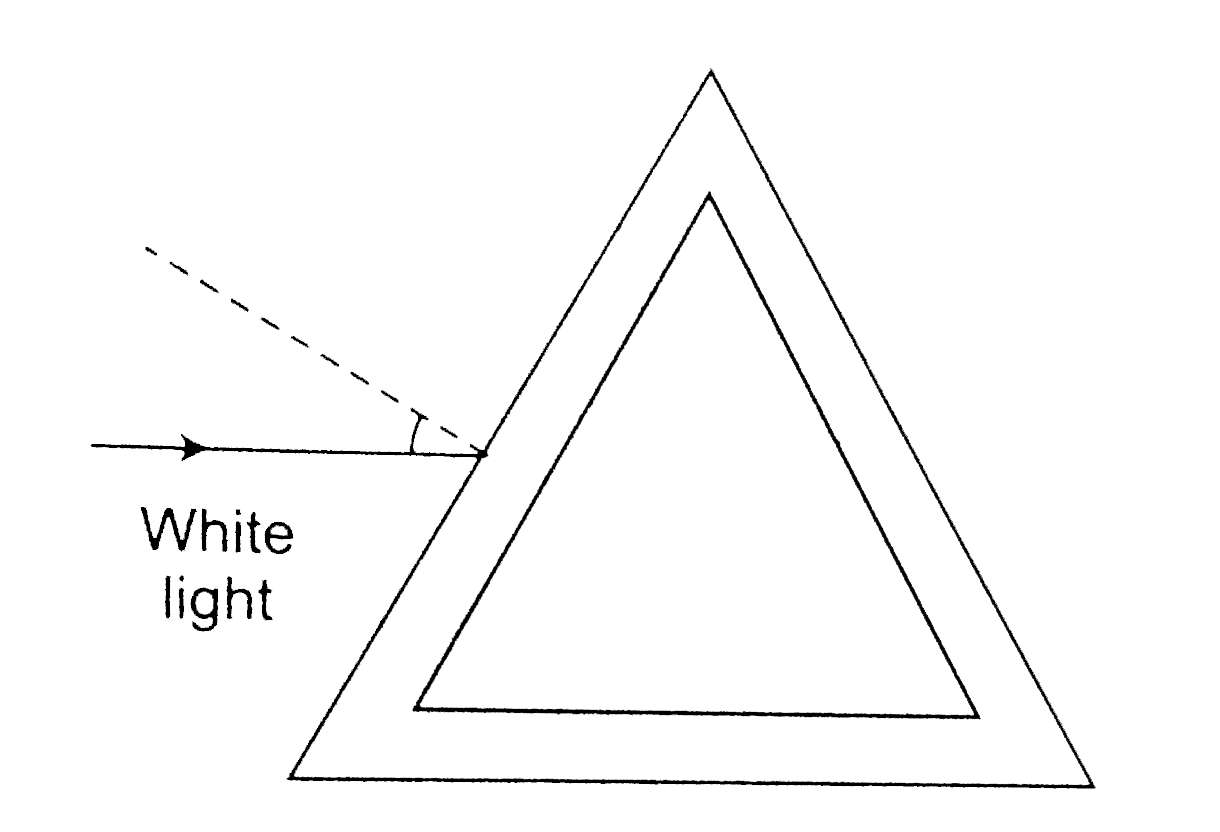A student is performing an experiment with two triangular glass prisms. He places the first glass prism on its base. The second glass prism is placed upside down behind the first glass prism. When a beam of white light is allowed to fall on the first glass prism, then a patch of ordinary white light is obtained on a screen placed behind the second glass prism.
(a) Draw a ray diagram to show the above· arrangement of two glass prisms and the light passing through them.
(b) What is the function-of (i) first prism, and (ii) second prism, in this arrangement?
Step-by-Step Solution
1. Draw the First Prism:
- Start by drawing a triangular prism on its base. Label it as Prism 1.
2. Draw the Second Prism:
- Draw another triangular prism upside down behind the first prism. Label it as Prism 2.
3. Incident Ray:
- Draw a straight line representing a beam of white light (incident ray) approaching the first prism at an angle.
4. Refraction at the First Prism:
- As the incident ray enters Prism 1, draw the refracted rays dispersing into a spectrum of colors (red, orange, yellow, green, blue, indigo, violet). This shows the dispersion of light.
5. Emerging Rays from the First Prism:
- Draw the dispersed rays exiting Prism 1, spreading out into the colors of the spectrum.
6. Entering the Second Prism:
- Draw the dispersed rays entering Prism 2. Since Prism 2 is inverted, the rays will be directed towards the base of the prism.
7. Refraction at the Second Prism:
- As the rays pass through Prism 2, they will converge back together. Draw the converging rays emerging from Prism 2.
8. Screen:
- Finally, draw a screen behind Prism 2 where the converged light forms a patch of ordinary white light.
(b) Functions of the Prisms:
1. Function of the First Prism:
- The first prism (Prism 1) acts as a dispersing prism. Its function is to separate the white light into its constituent colors (spectrum) due to refraction.
2. Function of the Second Prism:
- The second prism (Prism 2) acts as a converging prism. Its function is to recombine the dispersed colors back into a single beam of white light.
- Start by drawing a triangular prism on its base. Label it as Prism 1.
- Draw another triangular prism upside down behind the first prism. Label it as Prism 2.
- Draw a straight line representing a beam of white light (incident ray) approaching the first prism at an angle.
- As the incident ray enters Prism 1, draw the refracted rays dispersing into a spectrum of colors (red, orange, yellow, green, blue, indigo, violet). This shows the dispersion of light.
- Draw the dispersed rays exiting Prism 1, spreading out into the colors of the spectrum.
- Draw the dispersed rays entering Prism 2. Since Prism 2 is inverted, the rays will be directed towards the base of the prism.
- As the rays pass through Prism 2, they will converge back together. Draw the converging rays emerging from Prism 2.
- Finally, draw a screen behind Prism 2 where the converged light forms a patch of ordinary white light.
- The first prism (Prism 1) acts as a dispersing prism. Its function is to separate the white light into its constituent colors (spectrum) due to refraction.
- The second prism (Prism 2) acts as a converging prism. Its function is to recombine the dispersed colors back into a single beam of white light.
Topper's Solved these Questions
Similar Questions
Knowledge Check
- Question 1 - Select One
A beam of white light is shone onto a glass prism. The light cannot be :
ADeviatedBDispersedCFocusedDRefracted - Question 2 - Select One
A beam of white light is incident on a hollow prism of glass. Then
 Athe light emerging from prism gives spectrum but the bending of all colours is always from baseBthe light emerging from prism gives spectrum, all the colours bend towards the base, the violet must and red and leastCthe light emerging from prism gives spectrum, all the colours bend towards base, the red the least and violet the mostDthe light emerging from prism gives no spectrum
Athe light emerging from prism gives spectrum but the bending of all colours is always from baseBthe light emerging from prism gives spectrum, all the colours bend towards the base, the violet must and red and leastCthe light emerging from prism gives spectrum, all the colours bend towards base, the red the least and violet the mostDthe light emerging from prism gives no spectrum - Question 3 - Select One
When a beam of white light passes through a glass prism,
the colour of light beam that deviates the least isAa BlueBb RedCc GreenDd Violet
A beam of white light falls perpendicularly on the first surface of a prism. Dispersion will take place
View SolutionWhen white light passes through a glass prism
View SolutionWhen a narrow beam while light is passed through a glass prism, the different wavelength travel thorugh the glass at
View SolutionWhen a beam of white light passes through a glass prism, it splits up into seven colours. This phenomenon is due to
View Solution…......................... light is deviated the least in the spectrum of white light obtained with a glass prism.
View Solution

